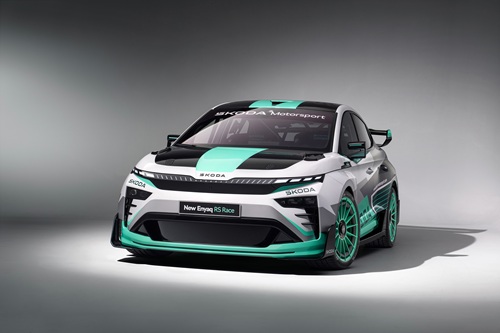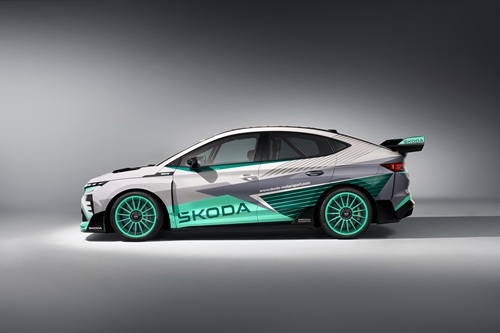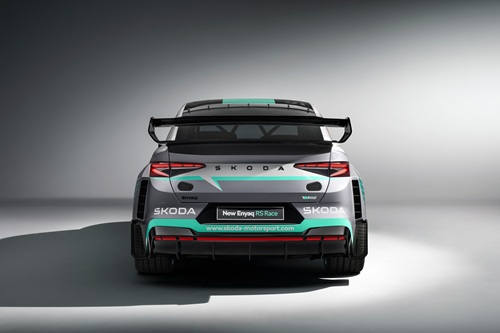Škoda Motorsport is showcasing the latest version of its recently presented all-electric racing car concept: the new Enyaq RS Race. Rooted in the Czech brand’s racing DNA, this concept supports the development of innovative technologies and sustainable materials, serving as a pilot project for future production models. The lower and wider concept car incorporates innovative, sustainable biocomposite parts that provide the same rigidity and weight advantages as carbon fibre, contributing to an overall weight reduction of more than 300kg compared to the new Škoda Enyaq Coupé vRS on which it is based.
Škoda Motorsport engineers have developed an all-electric race car that closely matches the handling of the successful Škoda Fabia RS Rally2. Škoda’s racing DNA and the rigorous demands of motorsport continue to push the boundaries of technical innovation. Development of the first Enyaq RS Race began in 2023, followed by its world premiere in October 2024. With the new Enyaq RS Race, the teams used the expertise gained in developing the first concept and took it to the next level with the recently introduced new Škoda Enyaq Coupé RS. The project showcases Škoda’s activities in the field of electrified motorsport, driving progress towards a more sustainable future. The latest version of the concept car uses the same electric powertrain but is 70 mm lower, 72 mm wider at the front, and 116 mm wider at the rear. Most importantly, it is significantly lighter than the production model. Additionally, the concept benefits from numerous visual and technical modifications, including an optimised chassis, redesigned bumpers, as well as modified shock absorbers and springs. A completely new high-performance braking system, racing seats, and a roll cage ensure the highest possible active and passive safety. The vehicle’s front is now defined by the sleek, high-gloss black Tech-Deck Face, with Škoda lettering replacing the logo on the bonnet. The car is also equipped with new segmented LED rear lights.
To reduce the weight compared to the production model, Škoda Motorsport engineers employed innovative and sustainable materials and removed all components not needed for the car’s intended use. Additionally, they incorporated side and rear windows made of lightweight polycarbonate. These measures together resulted in total weight savings of 316kg. The introduction of sustainable biocomposite parts incorporating flax fibres, developed in collaboration with Škoda’s motorsport partner Bcomp, serves as a pilot for future production models. Replacing carbon, these lightweight parts are used in both the interior and the body, including the bumpers, fenders, roof, roof vent, and rear wing. Applications in the interior include the dashboard, door panels, and footrests for the driver and passenger. Additionally, the standard model’s panoramic glass roof has been replaced with a biocomposite panel.
A total of 16 vehicle components are made from sustainable materials, with natural flax fibres replacing carbon in both the interior and the exterior. These are tested under the most challenging racing conditions, for instance in the Škoda Fabia RS Rally2, alongside sustainable lubricants for engines, motors, transmissions and dampers. One example is AmpliTex, a technical reinforcement fabric made from renewable flax fibres grown in Europe. These woven fibres not only reduce vibrations in the interior and contribute to weight reduction but also serve as a visually appealing design element. Moreover, flax cultivation has a significantly lower impact on the soil compared to other crops.
Bcomp’s PowerRibs™ technology utilises extremely lightweight, high-performance natural fibres also made from flax. PowerRibs™ combine maximum stiffness and minimum weight by creating a 3D structure to reinforce the thin-walled panels of the car body. The benefits include raw material savings, weight reduction, and lower production costs due to using fewer consumables. The material offers comparable rigidity and weight advantages to carbon fibre while reducing CO2 emissions by approximately 85%. In the original Enyaq RS Race, Škoda Auto has used this material for the first time for large, complex components such as the front wings, side panel and bumpers. The engineers also made extensive use of 3D printing in preparing and producing the prototype, using recycled materials such as nylon and CO2-neutral biodegradable biopolymer filaments.
The new Enyaq RS Race features a Havas premium sound system that incorporates a digital sound amplifier to deliver a characteristic, exhilarating motorsport sound. This system is significantly more powerful than the unit in the new Enyaq Coupé vRS production model, and its tone can be adjusted. The Havas sound system features bigger loudspeaker units, one at the front and two at the rear. The sound is also activated at speeds above 18 mph, ensuring an exciting acoustic experience throughout the drive.
GR Snippets
- Lower, wider and significantly lighter: Škoda Motorsport develops an all-electric concept car based on the new Škoda Enyaq Coupé vRS
- Saving more than 300kg: The new concept car serves as a pilot project and incorporates ideas for future production cars, including sustainable and lightweight materials
- Carrying forward Škoda’s racing DNA: The new Enyaq RS Race features visual and technical upgrades, including a widened, lower chassis, redesigned bumpers, enhanced shock absorbers and a roll cage


